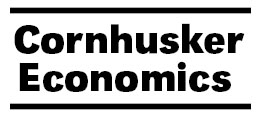Agricultural Economics, Department of

Cornhusker Economics
Date of this Version
2010
Document Type
Newsletter Issue
Citation
Cornhusker Economics
Abstract
In 2009, agricultural producers participating in federal farm programs had to make a decision between staying in the existing Direct and Counter-Cyclical Program (DCP) and the new Average Crop Revenue Election (ACRE) Program. If producers chose to keep the DCP, their farm income safety net is strictly tied to crop prices with a combination of marketing loans, counter-cyclical payments and direct payments. If producers chose the new ACRE program, they changed their farm income safety net to a combination of price and revenue. The new ACRE component is based on revenue and replaces the counter-cyclical payment. The other parts of the safety net for ACRE participants remain tied to price, albeit at lower levels (direct payments reduced 20 percent, marketing loan rates reduced 30 percent).


Comments
Published by the Department of Agricultural Economics, University of Nebraska-Lincoln. Copyright 2010 Regents of the University of Nebraska.